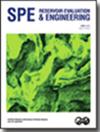砂岩和碳酸盐岩储层毛细脱饱和度曲线研究综述
IF 1.5
4区 工程技术
Q3 ENERGY & FUELS
引用次数: 1
摘要
在一次和二次采油阶段之后,采用各种提高采收率(EOR)的方法来达到剩余油饱和度(ROS)的目标。剩余油分为旁路油和毛细管圈闭剩余油。当粘性力或重力力超过毛细力时,通常可以动员储层中的剩余油。利用毛细管去饱和曲线(CDC)研究了微观捕获剩余油的回收。为了优化碳酸盐岩和砂岩储层各种提高采收率方法的设计,需要对CDC有一个基本的了解。为了确定砂岩中的剩余油和生成CDC,进行了一项全面而有充分文件证明的研究。然而,关于碳酸盐岩的研究报道非常有限。因此,本文的主要目的是提供近几十年来碳酸盐岩和砂岩储层CDC研究的最新进展。基于捕获/键/毛细数讨论了不同的CDC研究,并进行了批判性分析。此外,还研究了润湿性、渗透率、界面张力(IFT)和非均质性等不同控制因素对CDC的影响。这一综述分析表明,碳酸盐岩的CDC范围比砂岩更广。这是由于微孔的存在、大孔径分布、复杂的地质特征、化学反应性、混合-油-湿特征以及碳酸盐岩的非均质性。此外,文献报道的碳酸盐岩注水临界毛细数在10-8 ~ 10-5之间。另一方面,对于砂岩,这个数字在10-5到10-2之间。此外,还观察到润湿性对CDC形状的主要影响。油湿岩石的CDC形状更宽,毛细数值高于水湿和混合湿岩石。另一方面,在水湿岩石中观察到的毛细数值最低。该研究结果将为砂岩和碳酸盐岩的CDC研究提供一个方向。此外,它将作为了解各种cdc的基准,从而更好地筛选针对不同类型储层岩石的各种EOR方法。本文章由计算机程序翻译,如有差异,请以英文原文为准。
A Comprehensive Review on the Capillary Desaturation Curves for Sandstone and Carbonate Reservoirs
Various enhanced oil recovery (EOR) methods are applied after primary and secondary recovery stages to target remaining oil saturation (ROS). This remaining oil is divided into bypassed oil and capillary-trapped residual oil. Mobilizing the residual oil in the reservoir is usually achieved when viscous or gravity forces exceed capillary forces. The recovery of the microscopically trapped residual oil is mainly studied using capillary desaturation curve (CDC). To optimize the design of various EOR methods in carbonate and sandstone reservoirs, a fundamental understanding of CDC is needed. A thorough and well-documented research study has been performed for determining the residual oil and generating CDC in sandstone rocks. However, a very limited amount of work has been reported on carbonate rocks. Thus, the main objective of this paper is to provide the recent development made over the last few decades on the CDC studies for carbonate and sandstone reservoirs. Different CDC studies were discussed based on the trapping/bond/capillary number and were critically analyzed. Furthermore, the effects of different controlling factors—wettability, permeability, interfacial tension (IFT), and heterogeneity—on CDC were investigated.
This review analysis indicates that CDC in carbonate rocks is broader as opposed to sandstone rocks. This is because of the presence of micropores, large pore size distribution, complex geological characteristics, chemical reactivity, mixed-to-oil-wet characteristics, and heterogeneity of carbonate rocks. Moreover, the critical capillary number for water injection in carbonate rocks reported in the literature lies between 10–8 and 10–5. On the other hand, for sandstone rocks, the number ranges between 10–5 and 10–2. Furthermore, a major influence of wettability on the shape of the CDC was observed. The CDC shape is broader for oil-wet rocks, and capillary number values are higher compared to water-wet and mixed-wet rocks. On the other hand, the lowest capillary number values are observed in water-wet rocks. The outcome of this research study will provide a way forward for CDC studies in both sandstone and carbonate rocks. Additionally, it will serve as a baseline for understanding various CDCs and hence better screening of various EOR methods for different types of reservoir rocks.
求助全文
通过发布文献求助,成功后即可免费获取论文全文。
去求助
来源期刊
CiteScore
5.30
自引率
0.00%
发文量
68
审稿时长
12 months
期刊介绍:
Covers the application of a wide range of topics, including reservoir characterization, geology and geophysics, core analysis, well logging, well testing, reservoir management, enhanced oil recovery, fluid mechanics, performance prediction, reservoir simulation, digital energy, uncertainty/risk assessment, information management, resource and reserve evaluation, portfolio/asset management, project valuation, and petroleum economics.

 求助内容:
求助内容: 应助结果提醒方式:
应助结果提醒方式:


